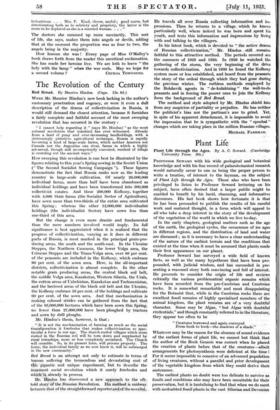The Revolution of the Century
Red Bread. By Maurice Hindus. (Cape. 12s. 6d.) WERE Mr. Maurice Hindus's new book lacking in the author's customary penetration and cogency, or were it even a dull description of the drama of collectivization in Russia, it would still demand the closest attention, because it furnishes a fairly complete and faithful account of the most sweeping revolution that has occurred in the century : "I cannot help regarding it" (says Mr. Hindus) "as the most colossal revolution that mankind has ever witnessed. Already from a land of puny and ever-decreasing landholdings, with a distressingly primitive agricultural technique, Russia is rapidly becoming a land of large-scale farms, which neither America nor Canada nor the Argentine can rival, farms in which a highly advanced, though still incompetently executed, method of tillage is crowding out the ancient ways."
How sweeping this revolution is can best be illustrated by the figures relating to this year's Spring sowing in the Soviet Union (" The Second Socialist Sowing Campaign "). These figures demonstrate the fact that Russia ranks now as the leading country in large-scale cultivation. Of nearly 26,000,000 individual farms, more than half have been abandoned as individual holdings and have been transformed into 200,000 collectivist estates. And these 200,000 Kolhozy, together with 4,000 State farms (the Socialist Sector of Agriculture), have sown more than two-thirds of the entire area cultivated this Spring ; whereas the other 12,000,000 individualist holdings (the individualist Sector) have sown less than one-third of this area.
But the change is even more drastic and fundamental than the mere numbers involved would imply. Its full significance is best appreciated when it is realized that the progress of collectivization, varying as it does in different parts of Russia, is most marked in the principal grain-pro- ducing areas, the south and the south-east. In the Ukraine Steppes, the Northern Caucasus, the lower Volga area, the Crimean Steppes and the Trans-Volga area, over 80 per cent. of the peasants are included in the Kolhozy, which embrace 90 per cent. of the sown area. Here, in the all-important districts, collectivization is almost complete. In the other notable grain producing areas, the central, black soil belt, the middle Volga area, Kazakstan, Western Siberia, the Urals, the cotton areas of Uzbekistan, Kaxakstan and Turkmenistan, and the beetroot areas of the black soil belt and the Ukraine, the Kolhozy embrace 50 per cent, of the holdings and cultivate 00 per cent. of the sown .area. And that mechanization is making colossal strides can be gathered from the fact that of the 93,000,000 hectares which have been sown this Spring, no fewer than 27,000,000 have been ploughed by tractors and sown by drill ploughs.
Mr'. Hindus's thesis, however, is that :
"It is not the mechanization of farming as much as the _social (rails- figuration it forebodes that makes collectivization so .pee. tncular a force in our age. The thatch-roofed villages which 'seem rocked' in the Russian soil will be torn down and supplanted by rural townships, more or less completely socialized. The' Church will crumble. So, in its present form, will private property. The home, the individual family as we now know it, will be submerged in the new community."
Red Bread is an attempt not only to estimate in terms of tunnan suffering the tremendous and devastating cost' of
gigantic and Unique experiment; Ina to descrihe. the imininent social revolution which it surely forebodes and
already in process.
Vindus has discovered a new approach to, the oft: told story :tit the .Russian .RevolUtion. His matt:mills midway. between that of the straightforwardreporterand of the novelist4', He travels all over Russia collecting information and int. pressions. Then he returns to a village which he knows particularly well, where indeed he was born and spent his youth, and tests this information and impressions by living with and talking to the villagers.
In his latest book, which is devoted to "the active drama of Russian collectivization," Mr. Hindus.. still remains faithful to this attractive method. The periods covered are the summers of 1929 and 1930. In 1929 he watched the gathering of the storm, the very beginning of the drive towards collectivization. And in 1930 he found the Kolhozy system more or less established, and heard from the peasants the story of the ordeal through which they had gone during the previous winter. The ruthless methods employed by the Bolshevik agents in " de-kulakizing " the well-to-do peasants and in forcing the poorer ones to join the Kolhozy form the background of Red Bread.
The method and style adopted by Mr. Hindus shield him from any suspicion of partiality or prejudice. He has neither the publicist's bias nor the partisan's axe to grind. Yet, in spite of his apparent detachment, it is impossible to avoid the impression that he is sympathetic with the " epochal " changes which are taking place in the million Russian villages.
MICHAEL FARBMAN.


































 Previous page
Previous page